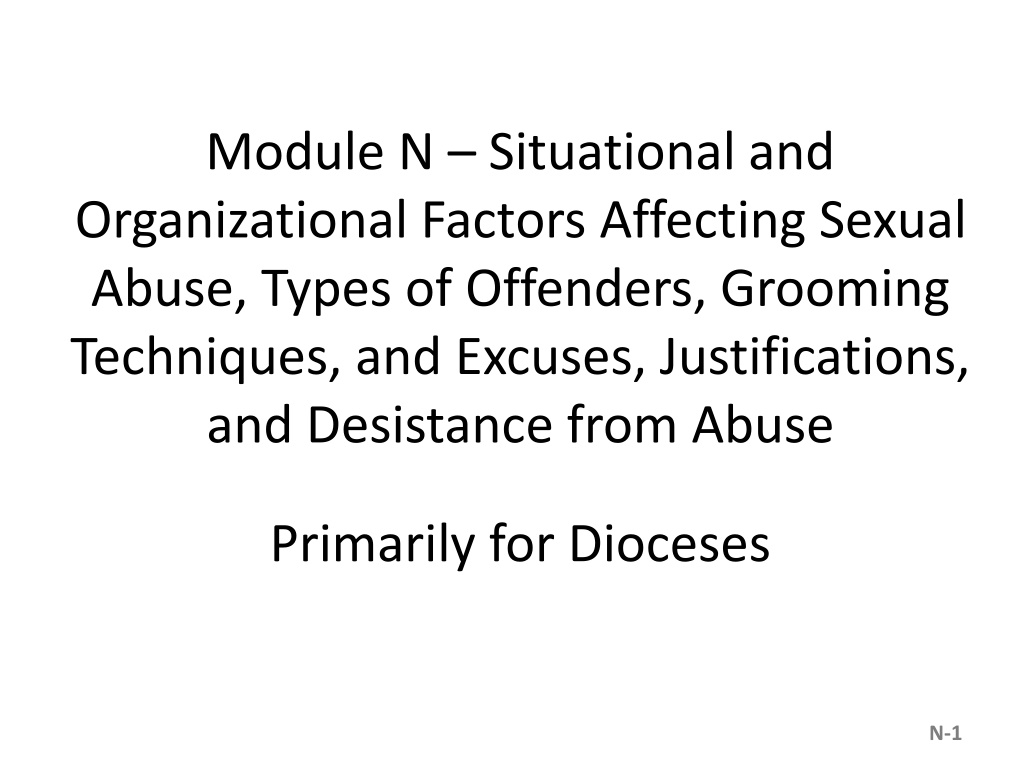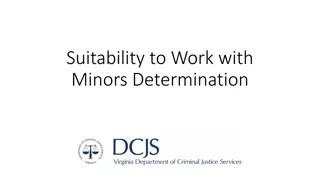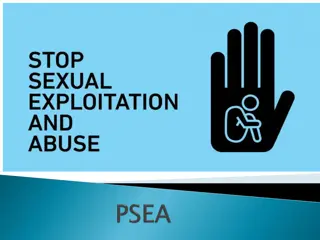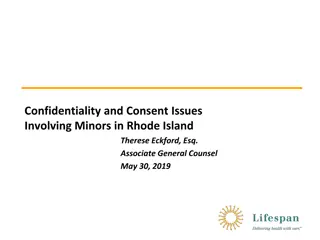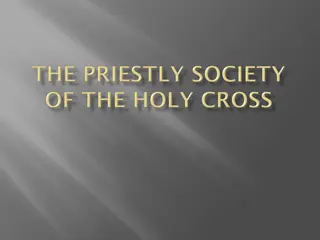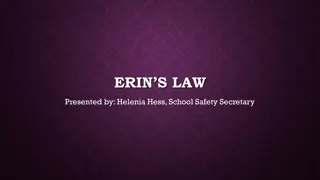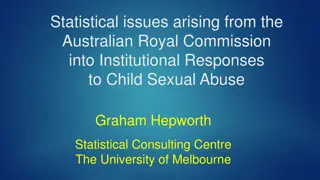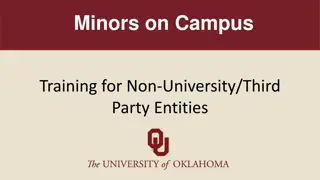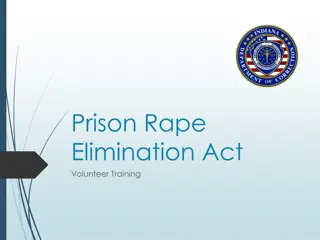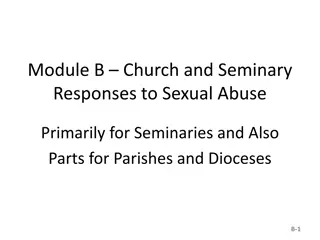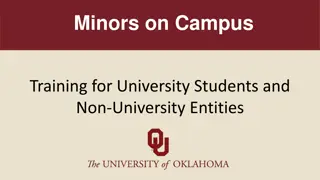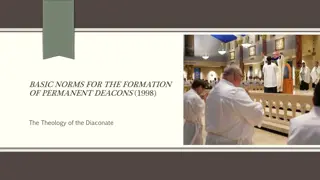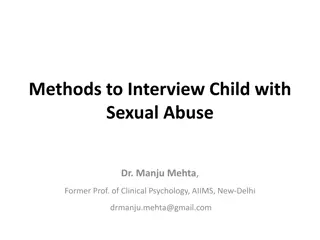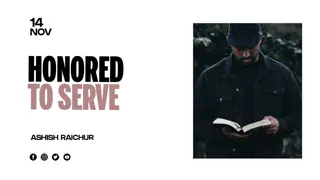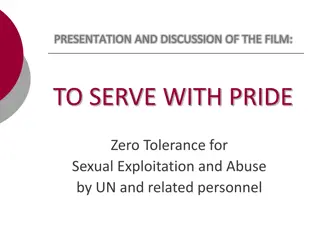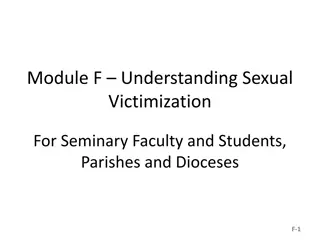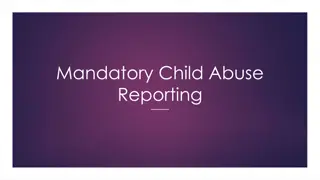Understanding Sexual Abuse of Minors by Catholic Priests
This content delves into the situational and organizational factors affecting sexual abuse of minors by Catholic priests, exploring types of offenders, grooming techniques, excuses, justifications, and desistance from abuse. It presents data from reports by the John Jay College Research Team and the United States Conference of Catholic Bishops, shedding light on settings and circumstances where victims first encountered offenders, such as in church-related environments, schools, and victims' homes.
Download Presentation

Please find below an Image/Link to download the presentation.
The content on the website is provided AS IS for your information and personal use only. It may not be sold, licensed, or shared on other websites without obtaining consent from the author. Download presentation by click this link. If you encounter any issues during the download, it is possible that the publisher has removed the file from their server.
E N D
Presentation Transcript
Module N Situational and Organizational Factors Affecting Sexual Abuse, Types of Offenders, Grooming Techniques, and Excuses, Justifications, and Desistance from Abuse Primarily for Dioceses N-1
Understanding Sexual Abuse of Minors by Catholic Priests: Situational Factors Organizational Factors Types of Offenders, Grooming, and Excuses, Justifications and Desistance from Abuse N-2
Main Sources of Data Reports presented to the United States Conference of Catholic Bishops by the John Jay College Research Team, The City University of New York* The Causes and Context of Sexual Abuse of Minors by Catholic Priests in the United States, 1950-2010, March, 2011 The Nature and Scope of Sexual Abuse of Minors by Catholic Priests and Deacons in the United States, 1950- 2002, February 2004 * The two reports are based on data supplied by 97 percent of U.S. archdioceses and dioceses on all clergy accused of sexual abuse of minors N-3
Part I. Situational Factors: Settings and Circumstances of Sexual Abuse N-4
Settings Where Victims First Met Priests Who Abused Them Location of First Meeting % Male Victims % Female Victims A. Church/Parish Related 64.8 58.9 B. School/Teacher 15.1 13.6 C. Home of Victim or Relative of Victim 4.9 14.2 D. Other Institutions 7.8 7.3 E. Other 7.1 6.2 Total 99.7 100.2 * % Based on Nature and Scope and victim survey of 7,142 boys and 1,762 girls. N-5
A. Church/Parish Related Location of First Meeting % Male Victims % Female Victims At Mass 33.8 27.1 At an Altar Service/In the Rectory 12.3 10.7 In the Parish 17.5 19.9 Home of Cleric 0.8 0.7 Choir 0.4 0.5 Total 64.8 58.9 N-6
B. Teacher/School Related Location of First Meeting % Male Victims % Female Victims Teacher (up to grade 6) 0.7 1.3 Teacher (grades 7-8) 0.9 1.4 Teacher (grades 9-12) 8.4 4.9 Sunday/Parish School 0.8 0.9 Other School 2.4 4.9 Seminary Faculty/Administrator 1.9 0.2 Total 15.1 13.6 N-7
C. Home of Victim or Relative of Victim Location of First Meeting % Male Victims % Female Victims Home of Victim/Social Function with Victim s Family 4.5 12.7 Cleric is Relative 0.4 1.5 Total 4.9 14.2 N-8
D. Other Institutions Location of First Meeting % Male Victims % Female Victims Boys Club/Youth Recreation 4.9 5.6 Work in Hospital 0.8 0.7 In Jail/Prison/Youth Offender Residence 1.2 0.1 Orphanage 0.9 0.9 Total 7.8 7.3 E. Other Location % Male Victims % Female Victims Other 7.1 6.2 N-9
Physical Locations of Abuse Location of Abuse % Male Victims % Female Victims A. Church/Parish Related 65.8 62.7 B. Residences 59.0 47.0 C. Other Locations 30.5 25.4 Note well: Clergy sexual abuse occurs in multiple settings Most frequently it is in church-related locations A wide range of residential contexts are used Other public and private venues also are exploited N-10
A. Church/Parish Related Locations of Abuse % Male Victims % Female Victims Cleric s Home/Parish Residence 36.3 30.7 In Church 14.2 12.9 In School 8.2 11.4 Cleric s Office 6.2 7.6 Congregate Residence 0.6 0.1 Total 65.8 62.7 N-11
B. Residences Location of Abuse % Male Victims % Female Victims In Victim s Home 10.9 10.4 Vacation House 9.9 5.0 In Other Residences (Friends, Family) 1.0 0.8 21.8 16.2 (Following residences also included in A above.) Cleric s Home/Parish Residence 36.6 30.7 Congregate Residence 0.6 0.1 Total 59.0 47.0 N-12
C. Other Locations Location of Abuse % Male Victims % Female Victims In a Car 8.5 8.4 In a Hotel 7.0 3.6 On Outings Camp, Park, Pool 7.8 5.7 Retreat House 1.2 1.5 In the Hospital 0.7 0.7 Other 5.3 5.5 Total 30.5 25.4 N-13
Circumstances/Timing of Abuse Circumstances/Timing % Male Victims % Female Victims A. Church/Parish Related 27.1 27.8 B. Social Event/Other Recreation 42.2 40.8 C. Other 14.4 16.2 Total 83.7 84.8 * Categories are not mutually exclusive, as victims may have experienced abuse in more than one location. N-14
A. Church/Parish Related Circumstances/Timing % Male Victims % Female Victims Visiting/Working at Cleric s Home/Rectory 13.2 13.1 Church Service (Before, During, After) 8.0 3.4 School Hours 4.2 8.2 During Reconciliation 1.3 2.8 Church Service, Training 0.4 0.3 Total 27.1 27.8 N-15
B. Social Event/Other Recreation Circumstances/Timing % Male Victims % Female Victims During Social Event 17.8 21.9 During Travel 14.0 7.2 Cleric Visited Home of Victim 2.9 7.4 During Sporting Event 4.5 2.5 Outings 3.0 1.8 42.2 40.8 N-16
C. Other Circumstances/Timing % Male Victims % Female Victims During Counseling 6.3 7.1 Hospital Visit 0.1 0.2 During a Retreat 0.8 1.4 Other 7.2 7.5 14.4 16.2 N-17
Part II. Organizational Factors Relating to Abuse N-18
Priests Primary Duty or Role at Time of Abuse Duty or Role % Male Victims % Female Victims A. Pastoral/Parish Related 77.2 80.2 B. Other Clerical Role 6.7 5.6 C. School/Teaching Role 8.7 5.6 D. Other 7.4 8.6 Total 100.0 100.0 * Based on Nature and Scope victim surveys of 7,864 boys and 1,863 girls. N-19
A. Pastoral/Parish Role Duty or Role % Male Victims % Female Victims Associate Pastor 42.2 42.1 Pastor 25.0 26.0 Resident Priest 8.8 10.9 Saying Mass 1.2 1.2 Total 77.2 80.2 N-20
B. Other Clerical Role Duty or Role % Male Victims % Female Victims Bishop, Vicar, Chancellor, Cardinal 0.4 0.2 Seminarian/Seminary Administration/Faculty 1.9 1.4 School/Institutional Administrator 1.0 1.7 Chaplain 2.8 2.1 Worked in Hospital 0.6 0.2 Total 6.7 5.6 N-21
C. School/Teaching Role Duty or Role % Male Victims % Female Victims Teacher (up to grade 6) 0.2 0.1 Teacher (grades 7-8) 0.3 0.4 Teacher (grades 9-12) 7.2 4.2 Guidance Counselor 0.9 0.6 Catechism Teacher 0.1 0.3 Total 8.7 5.6 N-22
D. Other Duty or Role % Male Victims % Female Victims Boys Club/Recreation 1.6 1.2 Cleric is Relative 0.3 1.0 Other 5.5 6.4 Total 7.4 8.6 N-23
A. The Fixated/Regressed Typology The distinction between fixated and regressed sexual offending exists on a continuum and is not simply a dichotomous distinction Two issues that differentiate the types: The degree to which deviant sexual behavior is entrenched The basis of the psychological needs that lead to abuse N-25
Fixated Offenders: Definition They have persistent, continual, and compulsive attraction exclusively to children from adolescence onward They are usually diagnosed with pedophilia, or recurrent, intense, sexually arousing fantasies of at least six months in duration involving prepubescent children N-26
Regressed Offenders: Definition They usually begin offending in adulthood Their offenses stem from stressors in the environment, which undermine self-esteem and confidence, and from disordered childhood relationships They are not necessarily motivated by sexual needs alone N-27
B. FBI Typologies: Situational Offenders, 1 Type of Offender Situational offenders Characteristics of Offenders Regressed Offenders have poor coping skills, target victims who are easily accessible, abuse children as a substitute for adult relationships Morally Indiscriminate Offenders do not prefer children over adults and tend to use children (or anyone accessible) for their own interest (sexual and otherwise) Sexually Indiscriminate Offenders are mainly interested in sexual experimentation, and abuse children out of boredom Inadequate Offenders are social misfits who are insecure, have low self-esteem, and see relationships with children as their only sexual outlet N-28
FBI Typologies: Preferential Offenders, 2 Type of Offender Preferential offenders Characteristics of Offenders Seductive much affection, love, gifts, and enticements in order to carry on a relationship Offenders court children and give them Fixated development, desire affection from children, and are compulsively attracted to children Offenders have poor psychosexual Sadistic violence, target stranger victims, and are extremely dangerous Offenders are aggressive, sexually excited by N-29
C. Personality Characteristics of Clergy Offenders, 1 Several researchers have concluded that clergy offenders are truly unique in comparison to offenders within the general population. One review of literature maintained that clergy offenders displayed shyness, loneliness, and passivity MMPI scores illustrated the presence of depression, authority concerns, and addiction problems Rorschach results indicated greater affect constriction than normal Offending clergy exhibited the presence of over- controlled hostility more than non-offending clergy N-30
Personality Characteristics of Clergy Offenders, 2 One of the specific clergy studies found that offenders came from backgrounds Characterized by rigidity and dysfunction with themes of abuse Had little insight into these areas Had insufficient training in the issue of transference/counter transference Had virtually no training or education concerning sexual abuse, domestic violence, addictive disease, or healthy professional boundaries, and Failed to appreciate how their history of trauma affected their professional life N-31
Onset of Abuse, 3: Overcoming External Factors that May Prevent Abuse from Occurring Abusers often create opportunities for the abuse to take place, such as socializing and building trust with the victim s family Abusers must overcome the child s resistance to the abuse, which is generally achieved through grooming tactics such as verbal and/or physical coercion, seduction, games, and enticements N-32
D. Grooming Behavior, 1 Grooming is a pre-meditated behavior intended to manipulate a potential victim into complying with sexual abuse Examples of various tactics or methods used to entice victims: seduction or manipulation verbal or physical intimidation provision of benefits such as tickets to sporting events, or taking them on trips, money, or other gifts building of personal and family relationships N-33
Grooming 2, Seduction and Testing of a Child This tactic is used when there is a relationship with a child and the child is accustomed to the affectionate expression of the offender The offender gradually extends the affectionate behavior, all the while testing the child s response; if no overt resistance is observed, the sexual abuse continues N-34
Grooming 3, Emotional Manipulation and Verbal Coercion These were the most common tactics used by offenders to groom their victims. Examples: - Doing favors for the victim in exchange for sex - Emotionally blackmailing the victim into compliance - Even though it may appear that there is room for negotiation on the part of the victim, the outcome always favors the offender N-35
Grooming 4, Catching the Victim by Surprise The offender orchestrates a situation to distract the victim or seizes the opportunity to abuse when it occurs A frequent situational opportunity arises when potential victims become altar servers or otherwise serve a role in the church Seizing the opportunity is most common and is usually the result of the offender s frustration from waiting for the right time to initiate contact N-36
Grooming 5, Using Verbal or Physical Force The offender garners victim compliance through use of force The offender either commands the victim to perform sexual acts and/or physically forces the victim to engage in sexual acts This factor is more common among the most serious, repeat offenders N-37
Grooming 6, Disguising Sexual Advances This tactic disguised sexual advances in the context of playing a game. Example: Offender will begin by tickling the victim and gradually progress to fondling While this approach may appear spontaneous, it has been well planned by the offender, yet orchestrated in a rather surreptitious manner N-38
Grooming 7, Using Alcohol and Drugs During the peak years of abuse, the use of alcohol and drugs by abusive priests increased significantly, but only for male victims Why this finding is important: The increase in the use of alcohol and drugs by the abuser is consistent with the increase in the abuse of males The increase in the abuse of males is consistent with the increase in the abuse of minors by priests The use of alcohol and/or drugs by the abuser is a feature of the situational or regressed child abuser, but not of the fixated abuser N-39
Grooming 8, Building Relationships with the Families of Victims Family relationships were built to gain trust Parents of abused children trusted the priests without reservation The children who were abused often accepted the abuse and did not report it for many years This lack of disclosure and concern about reporting the abuse was one reason it was able to persist N-40
Grooming 9, Effects of Grooming over Time Grooming tactics are premeditated and more methodically planned than spontaneous abuse The offender is willing to wait months or even possibly years to accomplish his task Eventually the victim becomes groomed to the point that engaging in sex with the offender is more or less automatic N-41
Part IV. Excuses for Behavior, Justifications for Behavior, and Desistance from Abuse N-42
Excuses for Behavior, 1: Denial of Responsibility Accused priests denied responsibility by making claims that They were not well (using or addicted to substances such as alcohol and/or drugs) They were compelled by sick or sinful impulses Forces beyond their control allowed them to deny full responsibility for their behavior, similar to legal claims of diminished capacity N-43
Excuses for Behavior, 2: Denying the Victim Accused priests denied the victim his or her status by claiming that the victim Participated by being seductive or precocious, or Did not fight back or say anything during the abuse Accused priests blamed the victim or the victim s family for setting up conditions that allowed the abuse to occur by inviting him into their home, engaging him socially, and including him as part of the family N-44
Excuses for Behavior, 3: Denying the Victim Accused priests explicitly blamed victims by placing the onus of the initiation of the physical intimacy on the accuser Referred to the abuse as a relationship Noted that the victims were willing or precocious Considered themselves the victims because they were accused of these indecent acts N-45
Justifications for Behavior, 1 Accused priests justified their actions by Diminishing the wrongfulness of the behavior Deflecting the harmfulness of the actions Placing the responsibility for the deviance on others, sometimes actually condemning the condemners or criticizing their accusers Accused priests downplayed what actually occurred or used positive language surrounding the relationship between themselves and the victim N-46
Justifications, 2: Minimization of Harm Many priest-abusers explained their actions as being part of a relationship, not sex, or that it happened only once, or occurred long ago Viewed the sexual behavior as consensual, not harmful, and any behavior short of intercourse as not wrong because it was not sex Insinuated that a single incident of sexual behavior was not harmful; only repetitive acts caused harm Implied that the harm should be forgotten because of the time between the incident(s) and the accusation N-47
Justifications, 3: Condemning the Condemners This behavior is a deflective technique in which priest-abusers blamed church leaders for the abuse and/or the responses to the accusation One way of shifting the blame to the church hierarchy was to say how poorly church leaders prepared seminarians for life in the priesthood They also blamed church leaders for how ineffectively they dealt with accusations of abuse, which they considered reactive and unforgiving N-48
Justifications, 4: Condemning the Condemners This form of justification draws on the culture of forgiveness: accused priests noted that the Catholic practice of reconciliation should outweigh the sins and no one should take action against them in response to allegations This view essentially eliminated the penance aspect of reconciliation; some priests stated that public embarrassment was sufficient penance This attitude was particularly true for those who participated in psychological treatments, but were still removed, or served jail time N-49
Justifications, 5: Condemning the Condemners Some clergy accused of sexual abuse believed that the 2002 Charter for the Protection of Children and Young People created a negative attitude particularly because of the zero-tolerance policy for those accused of abuse They felt they were denied due process They believed that if only their leaders had done things differently in the past, this crisis would have been avoided In particular they felt they were poorly socialized to the life of a priest N-50
